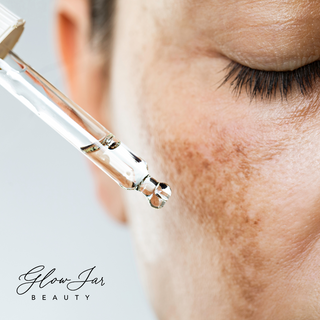If you struggle with hyperpigmentation from melasma, you’re not alone. According to some statistics, as many as 33% of people - about 90% of whom are women - will experience melasma, which tends to be most common during pregnancy, and between the ages of 20-40.
What is melasma and what causes it?
Also referred to as “the mask of pregnancy” or the “butterfly mask”, melasma is technically a skin disorder that causes the skin to produce excess melanin and darken in a symmetrical pattern which can cover the cheeks, chin, nose, upper lip, and forehead. When I was pregnant with my oldest, I had symmetrical brown patches under my eyes and a round patch on my upper lip. This symmetrical pattern is what distinguishes melasma from other forms of hyperpigmentation, such as dark spots, or discolouration.
In some cases, melasma can be a temporary side effect of hormone fluctuations, but in other cases can be a more chronic issue, exacerbated by factors such as UV exposure, heat, stress, genetics, and certain medications and health conditions.
A Few Helpful Tips for Melasma Management
What experts have discovered about melasma is that it occurs in some of the deepest layers of the skin, making it more difficult to treat. However, for minimizing the appearance of melasma and preventing it from worsening, there are some steps you can take with your daily care. Here are a few pointers we recommend:
Tip #1: Prioritize sun protection - Although hyperpigmentation related to melasma may occur deep within the lower layers of skin, it can appear darker with excess UV exposure. Therefore, it’s a good idea to avoid sun damage as much as possible, applying sunscreen often, and opting for mineral sunscreens, which will prevent your skin from absorbing heat from the sun.
Tip #2: Avoid excess heat from the skin - As we’ve already discussed, heat can play a pivotal role in triggering melasma. With this in mind, dermatologists suggest doing whatever you can to keep the skin from overheating. This includes avoiding hot showers or hot tubs, tanning beds, and any cosmetics that irritate your skin, as these things can lead to inflammation.
Tip #3: Seek out skincare products that target pigment - If you seek to treat your melasma with topical products, it will be especially helpful to look for ingredients that are naturally brightening and formulas designed to prevent excess melanin from forming. A few of our favourites include: Vitamin C, Tranexamic Acid, Niacinamide, Azelaic Acid, and Kojic Acid.
Our Product Pick: Glow Jar Beauty’s Radiance Brightening Serum
For a pregnancy safe option containing multiple melasma-fighting ingredients, be sure to check out our Radiance Brightening Treatment Serum. It features a powerhouse combo of 3% Tranexamic Acid, Niacinamide, Pea Extract, and Azelaic Acid for addressing dark spots, dull skin, uneven skin tone, and other pigment-related concerns.
References:
https://my.clevelandclinic.org/health/diseases/21454-melasma#:~:text=Melasma%20is%20a%20skin%20condition,and%20some%20treatments%20may%20help.

